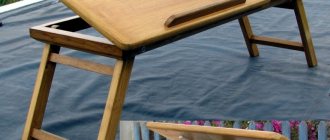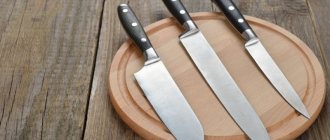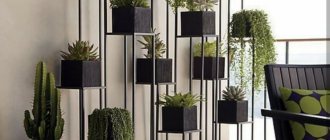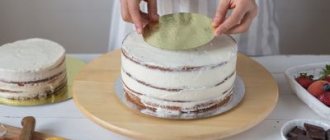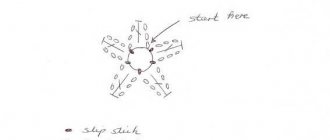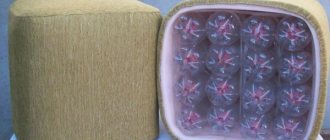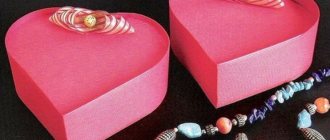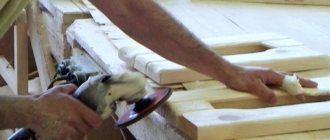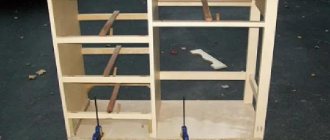- Preparing for work
- Assembling a cardboard shelf
- Master class on decor
Cardboard shelves are an indispensable furniture option if you can’t buy a new set.
A children's room or a summer house, a corridor or a kitchen - any room will be transformed if you place a convenient and practical shelf there. By doing it yourself, you can not only enjoy your skills, but also save some money. One of the cheapest and easiest materials to work with is cardboard. You can borrow it from any store, but to make a shelf it is better to go to a furniture store. The cardboard used there is quite durable and consists of 5 layers. Its thickness ranges from 5 to 10 mm - these are the optimal parameters for comfortable work.
In order to make any piece of furniture from cardboard with your own hands: a shelf, a bedside table, a decorative fireplace, you will need a number of tools and means to make the work easier. In addition to the main material, prepare:
- pencil, ruler, construction knife;
- a special surface for work, for example, a sheet of plywood;
- glue gun;
- glue "Moment";
- putty;
- wallpaper or self-adhesive for external decor.
Preparing for work
First you need to calculate the size of the shelf and the amount of material needed for it. The parameters will depend on its future location and your wishes. For our option, a project of 5 sections was chosen. The optimal height of the shelf is about 110 cm on the side with three sections, on the side with two - 69 cm. The width of the sections will be square, each side 30 cm.
The dimensions are known, you can start cutting the blanks. In total, you will need 2 blanks for each part, which are glued together:
- 4 parts with three sections;
- 8 pieces with two;
- 2 pieces from one.
By drawing out the details, you can calculate the size of the required sheet of cardboard. Do not forget to make all drawings in pencil, and make cuts with a construction knife. For convenient and high-quality work, use a thick, non-wooden ruler, as well as a good working surface that you won’t mind spoiling. She may be injured as a result of working with a knife.
After cutting, you will get separate cardboard shelves - parts that need to be assembled together. Before starting assembly, strengthen the structure with special stiffeners, which will add volume to the walls. To do this, you need strips of cardboard of arbitrary width (about 3-4 cm), which are placed around the perimeter of the part in a zigzag pattern.
Return to contents
Assembling a cardboard shelf
First, you need to glue all the parts and stiffeners with wood glue, since it does not deform the cardboard. Don't forget about the details placed around the perimeter. After careful gluing, place the blanks under the press. At home, they can be books or an overturned stool. When assembling, we connect all the parts in the cut out places, as if hooking them together.
Afterwards, you need to level the entire surface with putty, make the corners even, cover up holes or other manufacturing defects. This is necessary to obtain a flat surface, which will be easier to decorate later. Leave the shelves in a dry place for about 24 hours. After complete drying, make the product original, matching the style of your room.
You can make it out of cardboard with your own hands for a summer house or for a children's room.
In fact, I did not make this shelving unit from scratch, but on the basis of an old bedside table. However, if necessary, it can be made entirely from cardboard from absolute scratch.
In addition to the technique of making furniture from cardboard, I also used the technique of artificial aging and decoupage technique.
As promised, I’m sharing my experience step by step.
So, at the start I had this simple old bedside table from Soviet times:
The bedside table was completely covered with veneer and varnish, which adhered to it very firmly.
In such cases, it is recommended to remove the entire layer of decorative coating, but I must admit that this feat has never been possible for me. Therefore, I ignored this recommendation and simply laid all layers of paint and varnish on top. However, before painting, I cleaned and degreased the surface of the bedside table with white spirit, which can be purchased at any hardware or hardware store.
To make the rest of the rack, I used regular cardboard from regular cardboard boxes:
At first, like probably everyone else, I was tormented by the question, where will I get so many boxes? However, in practice, the mission turned out to be quite feasible.
As it turned out, cardboard boxes in stores are simply thrown away, so there are no obstacles to agreeing on their disposal. Especially good boxes are available in furniture and household appliance stores.
Well, of course, all my relatives and friends began to leave their empty cardboard boxes for me.
There are different technologies for making cardboard furniture walls of the required thickness and strength.
If the product is supposed to have thick walls, then it is best to fill the space between two sheets of cardboard with strips of cardboard of the appropriate width, gluing them perpendicular to the side sheets of cardboard.
However, in this case, I did not intend to make the walls of the rack too thick, so I used another method: simply glue several layers of cardboard together.
It must be said that cardboard comes in 3 and 5 layers. Three-layer cardboard has a wavy strip glued between two cardboard sheets, while five-layer cardboard has two wavy strips and three cardboard sheets.
Thus, if I came across sheets of five-layer cardboard, then I made four layers of cardboard for one part, and if I came across sheets of three-layer cardboard, then I made 6 such layers.
First, you need to cut out and cut out all the necessary parts of the future product in as many copies as will be required for further gluing of the layers in order to obtain the required thickness of each part.
In other words, I cut out six or four copies of each piece based on the thickness of the cardboard I had.
It is best to cut out parts with a sharp knife.
Each part needs to be signed so as not to get confused later, and it’s better to start working after all the parts have been cut out.
The next stage is gluing the parts. It is necessary to glue all layers of parts together to obtain the desired thickness of the product.
At the same time, I want to note that it is rarely possible to cut parts of the required size from a single piece of cardboard, but this is not scary. You can generally glue separate pieces of cardboard into the inner layers and try to make only the outer layers whole.
If this doesn’t work out, then that’s okay too. You can glue them from separate fragments and then prime the seams and cracks for further processing.
It is best to glue the layers with PVA glue.
It is best to lay the glued parts on the floor so that the cardboard does not sag from the glue and the parts are not deformed, and evenly press down on top with a weight and leave to dry for a day.
When I glued the layers of the side walls of the rack, I made only the outer layer solid, and glued the inner layers from separate parts, leaving grooves in place of future shelves:
When the side walls were ready, I drove the shelves into the grooves, securing them in the grooves with glue, and also, putting a weight on them, left them to dry for a day:
To strengthen the shelves in the grooves, it is best to use super PVA glue. He literally tightly glues the parts together:
When the shelves were firmly glued to the side walls, I glued the top of the shelf to the bedside table, also using super PVA glue, and left the structure to dry under a load for a day:
To ensure the strength of the shelves, it is advisable not to make them longer than 60 cm. But since my bedside table was 90 cm wide, I strengthened the shelves by gluing an internal partition into the middle of each:
In order to make the side cuts of the shelves and walls of the rack even and to disguise the cuts of the layers of cardboard inside them, I used strips of cardboard with factory folds.
All boxes have such folds, from toothpaste to cake boxes:
If you paste them over the side sections, they will look even and neat:
I covered all the places where I came across uneven cardboard with thin, even cardboard. Such cardboard can be found on binders, for example.
The fact is that before painting, it is recommended to cover the finished structure with craft paper (thick wrapping paper) or plain paper. I did so.
However, apparently because I use water-based acrylic paints, both craft and plain paper wrinkled and dried out in waves. In addition, even on smooth areas, its joints clearly showed through the paint, and the look turned out to be completely bad.
So next time I will try to avoid this stage, which I captured in the bottom photo. However, this time I did exactly this:
To fix this defect, I had to first paint the entire rack with nitro enamel to isolate the paper covering from subsequent painting.
I then covered the shelving with concrete contact. Concrete contact forms a rough coating and promotes good adhesion of the putty to the glossy surface.
Then I filled in all the unevenness with white gypsum putty and sanded it after drying with sandpaper.
I really liked the result that I got after using gypsum putty. I was unable to sand the surface perfectly evenly, and the resulting potholes created the effect of scratches and gouges that form on furniture during its natural aging.
The result is this:
I needed to get the effect of a cabinet that had been repeatedly painted with different colors, and which had become worn in different places over time.
In addition, I also wanted to get the effect of the Provence style, which is characterized by rough, even clumsy coloring of furniture pieces. This effect is created by painting furniture in two contrasting colors.
First a layer of dark color is applied, and then a layer of light color is applied on top of it, and between the strokes of light color the dark layer of “old” paint begins to show through.
I like to use gold or bronze paint as a dark layer. Firstly, they are suitable for any color of furniture, and secondly, they give the furniture a noble shimmer of antiquity.
So I painted the rack first with a layer of gold paint:
On it I put a layer of acrylic paint the color of baked milk so that a layer of gold paint was visible between the strokes:
Then I carefully painted the shelf one more time with light acrylic paint:
In order to consolidate the aging effect, you need to carefully go over all corners and folds with a sponge dipped in gold paint. Just before doing this, you need to make a few test touches with a sponge on paper or cardboard to remove excess paint.
And you will get aged corners like this:
These are the paints that I used: white acrylic enamel, which I tinted with acrylic paint, gold paint and aqualac:
After painting, I decoupaged the cornice and shelving doors.
At the very end, I installed new hinges and handles on the doors, and the rack is ready.
The photo is slightly distorted in color. In fact, my shelving unit has a very rich warm baked milk color.
When it comes to cardboard furniture, many people are usually interested in its durability. I deliberately put weights with a total weight of 10 kg on the shelf. As you can see, the shelf can withstand it completely calmly:
OK it's all over Now. I wish you all success in your work.
Self-assembled cardboard shelves will be useful in everyday life for those who have a lot of things, but it is difficult to store them compactly due to the lack of a closet with the proper number of shelves. Cardboard shelves can be arranged as you wish and placed in large cabinet niches. The details of making shelves from scrap materials are described in detail in the step-by-step instructions.
Materials
To work you will need to prepare:
- cardboard boxes of the same size;
- level;
- ruler;
- sharp knife;
- brushes;
- water;
- carpentry glue.
Step 1
. You need to carefully disassemble the prepared boxes. In the future, they should be cut to glue together into cardboard cubes. You can see the principle of assembling shelves in the following schematic drawings.
Step 2
. After cutting the boxes into component parts, apply the markings shown in the photo to each of them.
Step 3
. According to the markings, cut out the blanks to create a shelf.
Step 4
. Using glue and a brush, glue the cardboard blanks together. Coat the parts along the outer edge with glue and apply a little adhesive material in the central part of the elements. Please note that if the glue is too thick, it can be diluted a little with water.
Step 5
. After gluing each element, send the resulting material under the press. As a last resort, you can use a thick piece of plywood or foam plastic, on which you will need to stand with your feet. Let the glue set and glue the next layer of cardboard. A total of four to six such layers will be needed, which depends on the initial thickness of the cardboard boxes.
Step 6
. In places where the grooves for fastenings will be located, there is no need to lubricate the cardboard with glue. This will make it much easier for you to cut them out after gluing.
Furniture made from cardboard is an original, affordable way to transform unnecessary material into an unusual, charming thing. In appearance, it is almost no different from furniture bought in a store, but it will cost much less. If you have cardboard boxes, you will only have to purchase paint and glue. By following certain rules for processing the material, cardboard interior items will be very durable and will not bend under the load of objects.
Furniture made from cardboard is an original, affordable way to transform unnecessary material into an unusual, charming thing.
By following certain rules for processing the material, cardboard interior items will be very durable and will not bend under the load of objects.
On the eve of the first steps of work, you need to decide on the design and construction of a cardboard shelf; it can have a classic shape, be in the form of a rack or some kind of figure (elephant, bear, other animals or images) - it all depends on your imagination and abilities. The simplest option available to everyone is a classic or shelf-rack, since its creation requires a minimum of skills. They require a creative approach, in most cases the ability to draw, and require more time to create.
Elegant design - you design the item yourself, relying on personal preferences.
Note!
You should not use cardboard racks in places of high humidity (bathroom, street), as they will quickly lose their original appearance and become unusable. It is also necessary to protect furniture from fire, it is very flammable.
Practicality - you will only need to spend money on purchasing the necessary tools.
It is best to fasten cardboard products together with special plastic clips, rather than gluing them together. In this case, it can be easily disassembled.
Cardboard furniture can be disassembled and reassembled at any time, which is very convenient when moving or during renovations.
In order to increase strength, place a second, slightly smaller one in a box made of thick corrugated cardboard. Then the structure will acquire sufficient rigidity and will be able to withstand serious loads.
You don’t have to waste time searching for a practical, something you like that will fit perfectly into your interior.
Cardboard furniture does not contain harmful, toxic or other hazardous substances.
By showing your imagination and creativity to the fullest, you will create a unique interior masterpiece that will be admired by your family and guests at your home.
How to make a simple cardboard book shelf
A small, creative, DIY bookshelf can take its rightful place above your desk. The shelf can have any shape, including round or oval.
We decide on the size, thickness and shape of the shelf. We draw the layout on single-layer cardboard and cut it out. We get a template. We take several sheets of corrugated cardboard, outline the template, and cut it out with a sharp knife. At this stage, an electric jigsaw will be a good help, with which you can cut several blanks in one pass. Don’t forget to place the corrugated sheets in different directions. Having cut the required number of blanks, we proceed to gluing. Since the surface is still not small, it is preferable to use quick-drying glue, for example, “Moment” liquid or furniture glue. When applying them, the cardboard will not get wet, and therefore will not become unusable.
We glue the blanks together in several pieces, but no more than five. We place each such semi-finished product under a press, at least overnight. Then we glue the semi-finished products together and again place the finished shelf under the press. We cover the cardboard shelf with parquet varnish if we want the texture and natural color of the material to be visible. Before using the varnish, sand the product a little, smoothing out any unevenness. Or we cover it with torn craft paper, then decorate it. We attach the shelf to the wall using a hidden type of fastening without visible fasteners.
Necessary materials and tools
- Cardboard. You should understand that the thicker the material, the stronger the furniture will be. There is an opinion that the dark color of cardboard indicates its high density and vice versa - light cardboard is thinner. However, do not rush to get rid of the thin material; it will be useful for gluing joints. Or glue thin cardboard together, thus obtaining thick cardboard. If you use this method, glue the waves of each subsequent layer perpendicular to the previous one.
- Scotch tape and glue. It is acceptable to use any type, but the best option would be Moment glue. Thanks to its properties, the cardboard does not get wet, all the necessary parts are quickly and securely fixed.
- Kraft paper is used to reinforce the edges of furniture; thin cardboard can be used instead.
- White paper or tracing paper. Stick it on the entire surface for easy decoration. Please note: before applying tracing paper or kraft paper, it must be torn, not cut.
- Stationery knife or jigsaw. Keep an eye on the sharpness of the tool; the accuracy and quality of cutting depends on it. Replace the cutting parts of the device more often. Using a jigsaw you can cut several layers of cardboard.
- To dry the glue faster, use a simple or hair dryer.
Durability - the service life of cardboard furniture will be long if it has not been exposed to dampness and was correctly processed during creation.
Guide to Making Cardboard Shelving
Idea No. 1. Shoe shelf
- You will need sheets of cardboard measuring 21x24 cm. Distribute them into 3 equal strips.
- Using a dull knife, you need to carefully push the strips so that they bend. Then you can glue the long sides of the sheet with colored tape. Next, make triangular oblong shapes from the sheets, secure them with tape.
- Thus, make the number of triangles you need. To fix such shelves, you need to glue the resulting triangles to whole sheets of cardboard with double-sided tape or glue. You choose the required number of rows and sections at your discretion.
- Instead of triangular sections, you can create oval ones by connecting them together as well. Calculate the required diameter for your shoes and glue the rectangular strips of cardboard so that they form an ellipse.
On the eve of the first steps of work, it is necessary to decide on the design and construction of the cardboard shelf; it can have a classic shape, be in the form of a rack or some kind of figure.
The dimensions of the desired shelf and the amount of materials depend on personal wishes.
Idea No. 2. Hanging shoe rack
- You will need several large sheets of cardboard. Based on the size of your shoes, draw the cardboard into equal rectangles and cut them out.
- Divide each of the rectangles into three parts and bend them. Bend the two sides obliquely and connect them together so that you get a pocket that is wide at the top and narrow at the bottom.
- The bottom of each pocket must be attached with glue or double-sided tape to the top of the previous one from the inside, leaving space for shoes.
- Such a shelf can be mounted on the door itself or on the wall near it - in any case, such an original solution takes up little space.
The simplest option available to everyone is a classic or shelf-rack, since its creation requires a minimum of skills.
Idea No. 3. Bookshelf
- The dimensions of the desired shelf and the amount of materials depend on personal wishes. The best option is a rack with five sections, 110 centimeters high on the side of three sections and 69 centimeters high on two sections. Each section will be square, the sides will measure 30 centimeters.
- For each part you need two blanks that need to be glued together. In total you should get 4 with three, 8 with two, 2 parts with one section.
- Make all drawings with a ruler, cut parts using a knife and a thick ruler. If you will be cutting on the floor or on a table, first ensure that the surfaces are protected from cuts.
- Before starting assembly, create additional stiffening ribs for the structure; they will create additional volume and strength for the walls. To do this, make strips of cardboard approximately 4 centimeters wide, glue them sideways in a wavy pattern around the perimeter of one part of the part, then attach the second part.
- Next, for good fixation, the workpiece needs to be put under the press. You can use stacks of heavy books or a stool as a press.
- After carefully gluing the parts, you can begin assembling the shelf; to do this, connect all the parts together in the cut out places, interlocking them with each other. Then level the surface with putty, smooth out the corners and hide all other imperfections. It will take a day for the shelves to dry completely. This will allow you to get a perfectly flat surface for easier decoration.
- Design the finished shelving to your liking.
Unusual, figured shelves are more difficult to manufacture.
Sandpaper is useful for sanding cuts.
Pros of DIY cardboard shelves
- Elegant design - you design the item with your own hands, relying on personal preferences.
- Practicality - you will only need to spend money on purchasing the necessary tools.
- Cardboard furniture can be disassembled and reassembled at any time, which is very convenient when moving or during renovations.
- You don’t have to waste time searching for a practical, something you like that will fit perfectly into your interior.
- Cardboard furniture does not contain harmful, toxic or other hazardous substances.
- Durability – the service life of cardboard furniture will be long if it has not been exposed to moisture and has been properly processed during creation.
By following certain rules for processing the material, cardboard interior items will be very durable and will not bend under the load of objects.
On the eve of the first steps of work, you need to decide on the design and construction of the cardboard shelf; it can have a classic shape, be in the form of a rack or some kind of figure (elephant, bear, other animals or images) - it all depends on your imagination and abilities. The simplest option available to everyone is a classic or shelf-rack, since its creation requires a minimum of skills. Unusual, figured shelves are more difficult to manufacture. They require a creative approach, in most cases the ability to draw, and require more time to create.
Elegant design - you design the item with your own hands, relying on personal preferences.
Note! You should not use cardboard racks in places of high humidity (bathroom, street), as they will quickly lose their original appearance and become unusable. It is also necessary to protect furniture from fire, it is very flammable.
Practicality - you will only need to spend money on purchasing the necessary tools.
It is best to fasten cardboard products together with special plastic clips, rather than gluing them together. In this case, it can be easily disassembled.
Cardboard furniture can be disassembled and reassembled at any time, which is very convenient when moving or during renovations.
In order to increase strength, place a second, slightly smaller one in a box made of thick corrugated cardboard. Then the structure will acquire sufficient rigidity and will be able to withstand serious loads.
You don’t have to waste time searching for a practical, something you like that will fit perfectly into your interior.
Useful recommendation: instead of paint, you can use wallpaper or fabric. Thus, your product will suit any unique interior or give it such a look.
Cardboard furniture does not contain harmful, toxic or other hazardous substances.
By showing your imagination and creativity to the fullest, you will create a unique interior masterpiece that will be admired by your family and guests at your home.
The final stage is decoration
You can decorate cardboard products with your own hands from any materials, it all depends on your wishes and fantasies - there are many options. The simplest ones are wallpaper, film, paint.
Cover the entire surface of the product with old pieces of wallpaper, or just the inside, and paint the outside in your favorite color. You can completely paint the shelves, or use stencils or create unique patterns or designs yourself.
The simplest way is to use self-adhesive film. It has an attractive appearance, quickly and reliably sticks to the surface, unlike wallpaper, it can be washed. If defects appear on the film or you want to change the design, just purchase and stick another one.
Unusual, figured shelves are more difficult to manufacture.
Master class: decorating a product using pages of glossy magazines
You will need:
- any paper for the base, newspapers can be used;
- glossy magazines;
- universal or PVA glue;
- acrylic lacquer.
It is also necessary to protect furniture from fire, it is very flammable.
Pencil, tape measure for measuring and drawing details.
Cut magazine pages into strips 1-2 centimeters wide, and twist them into tubes using a thin pencil or knitting needle. Glue the resulting glossy straws in a row onto the paper used as a basis. Then cut the canvas from the tubes into a suitable width corresponding to the location of the decoration and place it on glue. When the surface is dry, coat it with acrylic varnish.
The process is very long and tedious, but the effect is amazing.
It is best to fasten cardboard products together with special plastic clips, rather than gluing them together.
Another option for a cardboard laptop stand
You will need:
- stationery knife
- ruler (preferably metal)
- a place where you can cut (a board or a special mat)
- glue (PVA or hot).
* Please select part sizes according to the size of your computer.
* Make cuts on the parts about 6 cm.
* This stand was designed for 13 and 15-inch laptops.
* Use glue to secure all parts, starting with the bottom ones.
*Allow the glue to dry before testing the stand.
Master class: surface decoupage
You will need:
- napkins with drawings;
- acrylic paints, acrylic varnish and brushes;
- scissors;
- iron.
In order to increase strength, place a second, slightly smaller one in a box made of thick corrugated cardboard.
Materials for decorating the finished product - paints, wallpaper, fabric and everything else your imagination desires.
Cover the surface of the rack with several layers of paint, let each layer dry, then apply another. Do not dry the very last layer completely; it should remain sticky. Remove the top layer from the napkin, run an iron over it and place it on the surface of the product. Place a clean sheet of paper on top of the napkin and iron it with an iron heated at low power.
Instead of paint, you can use wallpaper or fabric.
The napkin should completely stick to the surface, but if not, add a little paint under it with a brush and let it dry. Do not rush to the next step; the decoupage must dry thoroughly, otherwise the design will be deformed.
You should understand that the thicker the material, the stronger the furniture will be.
Please note: before applying tracing paper or kraft paper, it must be torn, not cut.
When the surface is completely dry, coat it with acrylic varnish.
However, do not rush to get rid of the thin material; it will be useful for gluing joints.
By showing your imagination and creativity to the fullest, you will create a unique interior masterpiece that will be admired by your family and guests at your home. Don’t be afraid to experiment, keep up with the times, because cardboard furniture is not only affordable, but also an original option for creating comfort and a unique atmosphere.
When buying a refrigerator, TV or other household appliances for your home, do not rush to throw away the cardboard packaging. With just a little effort and time, you can turn boxes into beautiful, functional and original furniture. For example, make a rack for storing shoes, shelves for books or a laptop stand.
How to make a cardboard table with your own hands?
As you understand, it is also easy to make from this material.
This could be a table for a child, a coffee table, or a coffee table. To make it, you will need almost all the same materials listed above, these are:
- corrugated cardboard;
- stationery knife;
- acrylic paint;
- acrylic varnish;
- adhesive tape;
- hot gun;
- PVA glue;
- cardboard tubes from rolled material.
For the legs you will need cardboard tubes. You can ask for this scrap material at a hardware store. Oilcloth or film is wrapped around it.
Once you have everything you need at hand, start creating. To make a tabletop, cut out two identical rectangles from cardboard and reinforce them with scraps of the same material. Cardboard strips need to be folded like an accordion and secured with an edge to one of the surfaces. The more of them, the stronger the finished products will be. Place the second table piece on top and glue it in the same way. Glue strips of cardboard and self-adhesive paper to the sides. Color the tabletop as you wish. In this case, red and yellow paint was used. Mark the hole for the legs and cut here with a utility knife. Insert them, secure with a hot gun. This is how the original table turned out, which, despite the fact that it was made of pressed paper, turned out to be quite durable.
If you also want to make furniture out of cardboard, be sure to try making it. The promised plot will help you with this, because such a shelf is very easy to make, the result is simply wonderful.
If you want to see what other furniture made of cardboard can be, including beds, stools, chairs, then check out the presented photo selection.
When buying a refrigerator, TV or other household appliances for your home, do not rush to throw away the cardboard packaging. With just a little effort and time, you can turn boxes into beautiful, functional and original furniture. For example, make a rack for storing shoes, shelves for books or a laptop stand.
What materials and tools will be useful in your work?
To make a rack or shelf from cardboard you will need:
- The main material is cardboard. It is best to take a dense one, the strength of the furniture will depend on this. It is believed that the denser the cardboard, the darker it is. However, thin sheets should not be thrown away either. They can be used for gluing joints.
- Any glue will do, but it’s better to use Moment. It doesn't make the paper wet.
- A stationery knife - the sharper it is, the more accurate the cutting will be.
- Sharp scissors.
- Dull knife.
- Roulette.
- Sandpaper.
- Kraft paper.
- Pencil, eraser.
- Dye.
- Remains of wallpaper.
- Colored tape.
Creative shelves for children's books
When thinking about making a bookshelf with your own hands for children, consider cardboard as the main material. In addition to the fact that it is environmentally friendly, products made from it are lightweight, which minimizes the risk of injury to a child when a shelf falls.
In order for the shelves to carry a developmental load, we will make them in the form of funny animals. The child's delight begins from the moment the structure is assembled, where he takes an active part. With such a creative book shelf, your baby will quickly learn order. Now the books will have their own funny children's shelves, which will be a pleasure to put in order. It will be difficult to draw up a diagram of a puzzle shelf in the shape of an animal yourself if you are not familiar with drawing programs, and even with drawing itself. You will have to look for the diagram, which is not very difficult.
You won’t believe it, but furniture made from cardboard is quite strong and durable. See how to make a chest of drawers, shelves, and a table from this material.
It seems that this material is unreliable, but it is not. Using certain technologies, you will make furniture from cardboard that can withstand considerable loads. This one is perfect for a child’s room, it is environmentally friendly and it won’t be a pity if a child scratches or draws on such an inexpensive item.
Master class No. 1
We recommend starting work by making a shelving unit yourself from cardboard. By strictly following the instructions, even a novice master can cope with the task.
- Divide sheets of cardboard measuring 21x24 cm into three even parts. Press the joints with a dull knife (the sheets should bend freely).
- Cover the long sides of the sheet with colored tape.
- Fold the sheets into triangles and secure with tape. You can make any number of triangles, depending on how many pairs of shoes you plan to store in the shelf.
- Assemble the rack. To do this, simply glue the triangles together. Place a flat sheet of cardboard on top. It will serve as a stand for high boots.
Master class No. 2
From sheets of cardboard you can make not only a shoe rack, but also hanging shelves. They will be a real find for owners of apartments with a small hallway, in which every centimeter of space counts.
How to make cardboard shelves with your own hands:
- Divide two large sheets of cardboard into rectangles (the size of your shoes) and cut them.
- Roll each rectangle into a pocket and secure with tape.
- Insert the pockets into each other, leaving space between them for shoes. Secure with tape.
The stages of work are clearly presented in the photo below.
- Attach the structure to the door. A functional and inexpensive rack is ready. If you wish, you can cover it with the remnants of old wallpaper or paint it with paint.
Master class No. 3
Today, almost everyone in the house has a laptop. In order not to store the gadget on the table, you can make a stand for it from cardboard. You will need the following in your work:
- thick cardboard,
- yardstick,
- several sheets of thin paper for a stencil,
- long ruler
- pencil,
- scissors,
- sharp stationery knife.
Having prepared the necessary tools and materials, begin making the rack.
- First of all, make a layout of the promenade. Take a sheet of paper and spread it on a flat surface. Measure the width of the laptop with a tape measure. Mark exactly half of the resulting value on paper and draw a line. This will be 1/2 of the base of the leg.
- From the ends of the drawn line, measure up 4 and 7 cm, connect. You will end up with a rectangle.
- Visually divide the figure into three parts. The first is a straight line at a distance of 4 cm. The second is a curved line drawn to the 7 cm line (angle 45 degrees). The third part is a line from the right end of the segment to the 7 cm line at an angle of 45 degrees. The layout of the leg is clearly shown in the figure below.
- Let's start making the shelf legs. In the previous photo this is part No. 2. Transfer the parameters from the photo to your template. Separately, stop at drawing the clove, which will later keep your laptop from falling. In height, it should be at least a third of the thickness of the gadget. The slot in the leg for fastening the parts should not be in the middle, but at a distance of 1/3 from the edge, about 3 cm in height, 3–5 mm in width.
- Cut out the resulting paper templates.
- Let's make a leg. To do this, attach the paper template to the cardboard and carefully trace it with a pencil. Flip the template over to the other side and trace again. In the end, you will end up with one symmetrical piece. Cut it out with a utility knife.
- Let's make the legs. Attach the paper template of the second part to the cardboard, trace, cut. The planned model of the rack assumes the presence of two legs. Therefore, make the second leg in the same way as the first. The main thing is that they turn out the same.
- We combine the cardboard parts along the slots and secure them with glue.
You will get such a neat rack.
How to make furniture durable?
Many people fear that shelves made of cardboard will not be strong enough, and deprive themselves of the pleasure of having such original and useful interior items in their home. In vain! The following tips will help you make furniture out of cardboard with your own hands, which will not be inferior in strength to those made from other common materials.
- Open the finished pieces of furniture with parquet varnish.
- Give preference to symmetrical parts; they are stronger than irregularly shaped elements.
- The more cross parts a product has, the more stable it is.
- Use dark cardboard in your work; it is stronger than light cardboard.
Another trick will help give the furniture more density. When making all furniture elements, use two layers of cardboard, one with horizontal waves, the other with vertical ones.
You can make many original and useful interior items from cardboard. And you won’t have to spend extra money on this. Almost everything you might need for work is in everyone's home.
What you need to know about working with cardboard
This is absolutely free material if you ask for packaging boxes in hardware and furniture stores. The more layers of corrugation (waves), the stronger the material. Dark-colored cardboard is more durable than light-colored cardboard. The strength of the product is also determined by the staggered arrangement of the corrugations. Straight internal partitions and walls are made of cardboard of two or more layers. Curved, rounded partitions and walls are made of single-layer cardboard, which easily takes on various shapes. Smoother cardboard face.
You may need craft paper.
With it, torn into pieces, you will paste over a bookshelf with your own hands. This is a preparatory stage that will make the surface smooth and suitable for further decoration - painting or pasting with decorative paper. First, the edges and seams of the shelf are processed, then the rest of the surface. If the decor is planned to be light, use white paper. In other options, brown is used. The corners are taped with masking tape for strength.
Tools you will need:
Stationery paper knife; - long metal ruler; — sandpaper (which is used to polish the cuts); — thermal gun; — glue (wallpaper, PVA, liquid “Moment”, for furniture); — varnish for parquet (which will make the product durable and protect it from moisture).
